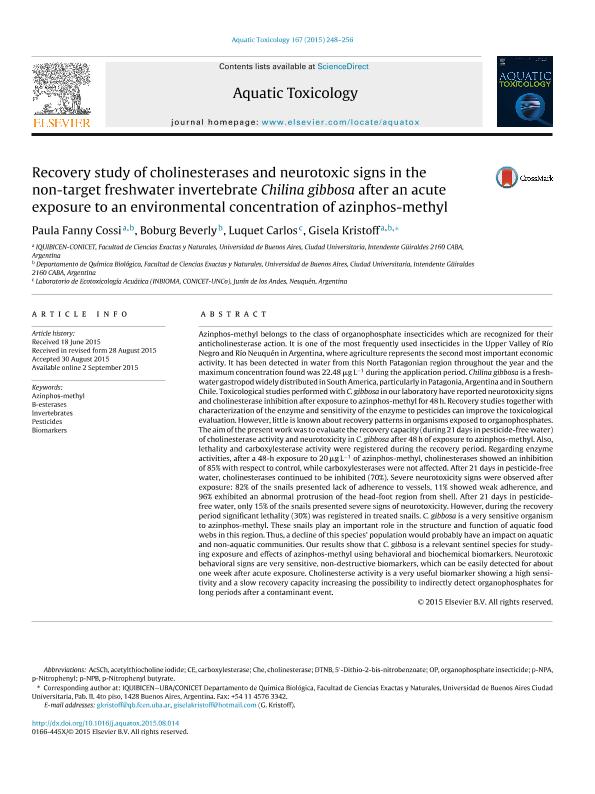Artículo
Recovery study of cholinesterases and neurotoxic signs in the non-target freshwater invertebrate Chilina gibbosa after an acute exposure to an environmental concentration of azinphos-methyl
Fecha de publicación:
09/2015
Editorial:
Elsevier
Revista:
Aquatic Toxicology
ISSN:
0166-445X
Idioma:
Inglés
Tipo de recurso:
Artículo publicado
Clasificación temática:
Resumen
Azinphos-methyl belongs to the class of organophosphate insecticides which are recognized for their anticholinesterase action. It is one of the most frequently used insecticides in the Upper Valley of Río Negro and Río Neuquén in Argentina, where agriculture represents the second most important economic activity. It has been detected in water from this North Patagonian region throughout the year and the maximum concentration found was 22.48 μg L−1 during the application period. Chilina gibbosa is a freshwater gastropod widely distributed in South America, particularly in Patagonia, Argentina and in Southern Chile. Toxicological studies performed with C. gibbosa in our laboratory have reported neurotoxicity signs and cholinesterase inhibition after exposure to azinphos-methyl for 48 h. Recovery studies together with characterization of the enzyme and sensitivity of the enzyme to pesticides can improve the toxicological evaluation. However, little is known about recovery patterns in organisms exposed to organophosphates. The aim of the present work was to evaluate the recovery capacity (during 21 days in pesticide-free water) of cholinesterase activity and neurotoxicity in C. gibbosa after 48 h of exposure to azinphos-methyl. Also, lethality and carboxylesterase activity were registered during the recovery period. Regarding enzyme activities, after a 48-h exposure to 20 μg L−1 of azinphos-methyl, cholinesterases showed an inhibition of 85% with respect to control, while carboxylesterases were not affected. After 21 days in pesticide-free water, cholinesterases continued to be inhibited (70%). Severe neurotoxicity signs were observed after exposure: 82% of the snails presented lack of adherence to vessels, 11% showed weak adherence, and 96% exhibited an abnormal protrusion of the head-foot region from shell. After 21 days in pesticide-free water, only 15% of the snails presented severe signs of neurotoxicity. However, during the recovery period significant lethality (30%) was registered in treated snails. C. gibbosa is a very sensitive organism to azinphos-methyl. These snails play an important role in the structure and function of aquatic food webs in this region. Thus, a decline of this species? population would probably have an impact on aquatic and non-aquatic communities. Our results show that C. gibbosa is a relevant sentinel species for studying exposure and effects of azinphos-methyl using behavioral and biochemical biomarkers. Neurotoxic behavioral signs are very sensitive, non-destructive biomarkers, which can be easily detected for about one week after acute exposure. Cholinesterse activity is a very useful biomarker showing a high sensitivity and a slow recovery capacity increasing the possibility to indirectly detect organophosphates for long periods after a contaminant event.
Palabras clave:
Azinphos-Methyl
,
B-Esterases
,
Invertebrates
,
Pesticides
,
Biomarkers
Archivos asociados
Licencia
Identificadores
Colecciones
Articulos(INIBIOMA)
Articulos de INST. DE INVEST.EN BIODIVERSIDAD Y MEDIOAMBIENTE
Articulos de INST. DE INVEST.EN BIODIVERSIDAD Y MEDIOAMBIENTE
Articulos(IQUIBICEN)
Articulos de INSTITUTO DE QUIMICA BIOLOGICA DE LA FACULTAD DE CS. EXACTAS Y NATURALES
Articulos de INSTITUTO DE QUIMICA BIOLOGICA DE LA FACULTAD DE CS. EXACTAS Y NATURALES
Citación
Cossi, Paula Fanny; Boburg, Boburg; Luquet, Carlos Marcelo; Kristoff, Gisela; Recovery study of cholinesterases and neurotoxic signs in the non-target freshwater invertebrate Chilina gibbosa after an acute exposure to an environmental concentration of azinphos-methyl; Elsevier; Aquatic Toxicology; 167; 9-2015; 248-256
Compartir
Altmétricas




